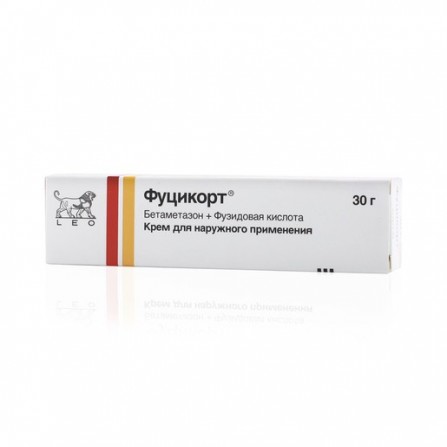More info
Active ingredients
Betamethasone + Fuzidovaya acid
Release form
Cream
Composition
1 g of fusidic acid hemihydrate 20.4 mg, which corresponds to the content of fusidic acid anhydrous 20 mg, betamethasone valerate 1.214 mg, which corresponds to the content of betamethasone 1 mg. Excipients: macrogol cetostearate - 18 mg, cetostearyl alcohol (cetyl alcohol 60%, stearyl alcohol 40%) - 72 mg, chlorocresol - 1 mg, sodium dihydrogen phosphate dihydrate - 3 mg, liquid paraffin - 60 mg, soft white paraffin ( 10 ppm α-tocopherol) - 150 mg, sodium hydroxide - qs, purified water - up to 1 g
Pharmacological effect
Combined preparation for external use containing antibiotic of polycyclic structure and GCS. Fuzidovaya acid is an antibiotic of polycyclic structure. It is active mainly against gram-positive bacteria, in particular - Staphylococcm aureus, Propionibacterium acnes and corynebacteria. The mechanism of action is associated with the suppression of bacterial protein synthesis. After 30 years of use, resistance of bacteria to fusidic acid is rarely observed (1-3%). Most often, bacteria resistant to penicillin and other antibiotics are susceptible to fusidic acid. Betamethasone belongs to the group of strong GCS (group III) and has a pharmacological effect, suppressing local immune reactions, including vasodilation, swelling and pain.
Indications
Infectious and inflammatory skin diseases caused by microorganisms sensitive to fusidic acid: dermatitis, infected allergic eczema, toksidermiya.
Contraindications
Rosacea Perioral dermatitis. Youth acne. Primary bacterial, viral and fungal skin diseases. Tuberculosis of the skin. Skin manifestations of syphilis. Children under 1 year of age. Increased sensitivity to the components of the drug.
Use during pregnancy and lactation
Caution should be used when perianal or genital pruritus; over large areas of skin, under occlusive dressings, face, areas of diaper rash; in the periorbital region, since however, glaucoma may develop. Bacterial resistance associated with the use of fusidic acid is noted. As with other antibiotics, excessive or repeated use of the drug may increase the risk of developing antibiotic resistance. Do not apply the drug to open wounds and mucous membranes. irritation or excessive skin sensitivity,its use should be discontinued and other appropriate treatment should be initiated. If discontinuation of treatment occurs, withdrawal syndrome may occur, manifested as redness, burning sensation or tingling of the skin or exacerbation of psoriasis. These phenomena can be prevented with the gradual withdrawal of the drug. After long-term external treatment with potent corticosteroids, atrophic changes are most often found on the face, the external genital organs, the inner side of the upper and lower extremities, compared to other sites. as well as cetostearyl alcohol, which can cause local skin rashes (for example, contact dermatitis). Use in pediatrics: Due to that in children the ratio of surface area and body weight is greater than in adults, children are at greater risk of suppressing the function of the hypothalamic-pituitary-adrenal system and the development of Cushing syndrome when using any GCS for external use. Prolonged treatment of children with GCS can lead to impaired growth and development of the body. When treating children, the drug should be used in the minimum effective dose. Influence on the ability to drive vehicles and control mechanisms The drug does not affect the ability to drive vehicles and control mechanisms.
Dosage and administration
Apply externally. Adults and children are applied a thin layer of cream on the affected area 2-3 times / day. The course of treatment is not more than 2 weeks.
Side effects
Drug interaction of the drug Fucicort is not known.
Interaction with other drugs
Precautionary measures
special instructions
Determination of the frequency of adverse reactions: very often (> 1/10), often (> 1/100 and less than 1/10), infrequently (> 1/1000 and less than 1/100), rarely (> 1/10 000 and less than 1 / 1000), very rarely (less than 1/10 000). On the side of the skin and skin appendages: rarely - rash, exacerbation of eczema, skin irritation, skin itching, burning sensation or tingling of the skin; frequency is unknown - skin atrophy, contact dermatitis, erythema, dry skin. Although these reactions were not noted in clinical studies of Fucicort, external use of GCS can lead to telangiectasia and striae, especially with prolonged use. As with other GCS, folliculitis is possible ( steroid acne), hypertrichosis, perioral dermatitis, depigmentation, hemorrhagic rash, acne rosacea, prickly heat, maceration of the skin, systemic effects of GCS. Allergic reactions: frequency unknown - urticaria.





